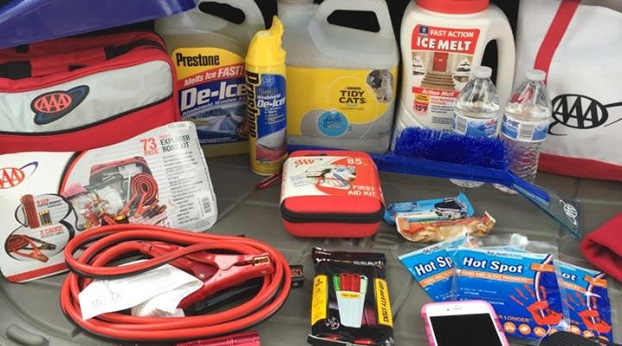AAA urges drivers to be safe, pack a vehicle winter emergency kit
Published 7:46 am Thursday, January 6, 2022
AAA is reminding drivers―many of whom were homebound last winter because of COVID-19―that snow means slow, and that doesn’t necessarily mean a lot of snow. Sometimes just an inch or two can lead to serious crashes if motorists do not adjust their driving behaviors for conditions.
“Many people were working from home last winter or otherwise able to avoid snow-covered roads. With more drivers now out and about, it is critical that they be reminded of what is at risk,” says Lori Weaver Hawkins, public affairs manager, AAA Blue Grass. “This has already been an exceptionally deadly year on Kentucky’s roadways. Add a little snow to the mix and the consequences will be tragic if drivers don’t adjust their behaviors for conditions.”
According to research by the AAA Foundation for Traffic Safety, winter storms, bad weather and sloppy road conditions are a factor in nearly half a million crashes and more than 2,000 road deaths every winter.
Winter driving preparedness
• Make certain your tires are properly inflated and have adequate tread. Colder weather typically requires increasing tire pressure. Make sure pressure levels match those found in the owner’s manual or the driver-side door jamb. Note that pressure levels may be different for front versus rear tires. You can easily check your tire tread by doing the quarter test. Take a Washington quarter and insert into the tire tread upside down, with Washington’s head going first. If the top of Washington’s head is visible at any point on the tire, you need new tires.
• Check battery. Staring an engine in cold temperatures can take up to twice as much current as needed under normal conditions. The average battery lasts 3 to 5 years in Kentucky’s climate. Make sure the battery terminals and cable ends are free from corrosion and the connections are tight. You can have the battery and charging system checked by a trained technician to ensure it is strong enough to face cold weather. AAA members can request a visit from a AAA Mobile Battery Service technician who will test their battery and replace it on-site, if necessary.
• Check wiper blades. The blades should completely clear the glass with each swipe. Replace any blade that leaves streaks or misses spots.
• Keep your gas tank at least half full to avoid gas line freeze-up. Condensation can sometimes form in the empty areas of a gas tank. During winter, it’s possible for this condensation to freeze inside the gas lines, meaning that it will prevent you from starting your vehicle. Your fuel pump could also be affected. When you are low on fuel, your fuel pump could begin sucking in air, causing it to overheat or even fail, resulting in costly repairs. In addition, it’s good to keep your vehicle’s tank at least half full in case of an emergency, should you be stranded and need to stay warm. Wintry weather can also cause unexpected traffic snarls, using more gas than you may have anticipated.
• Ensure your AAA membership is up to date. AAA members should travel with their membership card, download the AAA app to their mobile phone or otherwise have their membership number handy when calling for roadside assistance. Making sure your AAA membership is active to take advantage of roadside assistance is important and as simple as going to AAA.com or stopping in at a AAA retail location. AAA is reminding all vehicle owners to make sure their AAA Membership is up to date and offering significantly discounted memberships to first responders, teachers and members of the military.
Prepare a winter emergency kit
“Imagine yourself stranded roadside in the dark and the cold. Emergency supplies should include whatever you would need to keep you―and your passengers―safe and warm while waiting for help to arrive,” Weaver Hawkins says.
AAA recommended winter emergency kit should include:
• Abrasive material (sand, salt, cat litter) or traction mats
• Snow shovel
• Flashlight with extra batteries
• De-icer
• Ice scraper with brush
• Jumper cables
• Extra warm clothing (gloves, hats, scarves), and blankets
• Warning devices (flares or triangles)
• Drinking water and non-perishable snacks for both human and pet passengers
• First-aid kit
• Basic toolkit (screwdrivers, pliers, adjustable wrench)
• Mobile phone pre-programmed with rescue apps and important phone numbers including family and emergency services and charger.
Tips for driving in the snow
• Avoid driving while you’re fatigued. Getting the proper amount of rest before taking on winter weather tasks reduces driving risks.
• Never warm up a vehicle in an enclosed area, such as a garage, nor leave a running vehicle unattended.
• Drive slowly. Every maneuver takes longer on snow-covered roads. Be aware of traffic ahead and slow down even more if you start to see brake lights or fish tailing cars.
• Accelerate and decelerate slowly. Applying the gas slowly to accelerate is the best method for regaining traction and avoiding skids.
• Don’t follow behind other vehicles as closely as you would when driving in clear, dry conditions. Slick roads means your vehicle cannot slow down as quickly. Increase following distances to 8 seconds or more. This increased margin of safety will provide the longer distance needed if you have to stop. Do not tailgate. Try to always keep open space on at least one side of your vehicle, in case you need make an emergency lane change maneuver.
• Don’t be rough with your steering, acceleration and braking. If you are not gentle with steering, acceleration and braking, your vehicle’s balance can be negatively affected, increasing the chance of experiencing a skid. Always steer, accelerate and brake smoothly.
• Avoid braking on icy roads. Try to brake well ahead of stop signs and traffic lights, preferably in areas of clear pavement. Whether you have antilock brakes or not, the best way to stop is threshold braking. Keep the heel of your foot on the floor and use the ball of your foot to apply firm, steady pressure on the brake pedal.
• Don’t stop if you can avoid it. There’s a big difference in the amount of inertia it takes to start moving from a full stop versus how much it takes to get moving while still rolling. If you can slow down enough to keep rolling until a traffic light changes, without getting close to vehicles ahead of you, do it.
• Don’t power up hills. Applying extra gas on snow-covered roads just starts your wheels spinning. Try to get a little inertia going before you reach the hill and let that inertia carry you to the top rather than hard acceleration. Do not stop on your way up the hill. As you reach the crest of the hill, reduce your speed and proceed downhill as slowly as possible.
• Pull over. Whenever visibility is limited or you otherwise feel at risk, pull over at your first opportunity to do so safely.
• Don’t hit the brakes if you start to skid. Slamming on the brakes can make the skid even worse. If you are approaching a patch of ice, brake during your approach. Applying pressure to your brakes while on the ice will only throw you into a skid. If you do start to skid, ease off of the accelerator or brake and steer in the direction you want the front of the car to go.
• Never use cruise control on slippery roads. Cruise control will cause you to lose the ability to transfer more weight to the front tire by simply lifting off the accelerator. A driver should always be in full control of their vehicle during poor road conditions.
• Be sure your headlights are on. While many vehicles have automatic headlights, it’s important to be sure you are driving with your lights on to see and be seen.
• Limit distractions. This is important always, But in bad weather, drivers should be looking ahead in anticipation of any unexpected changes in road conditions or traffic.
• Avoid unnecessary lane changes. This increases the chances of hitting a patch of ice between lanes that could cause loss of vehicle traction.
If you get stuck in the snow or go off the road:
• Stay with your vehicle: Your vehicle provides temporary shelter and makes it easier for rescuers to locate you. Do not try to walk in a severe storm. It is easy to lose sight of your vehicle in blowing snow and become lost.
• Don’t over-exert yourself: When digging out your vehicle, listen to your body and stop if you become tired.
• Be Visible: Tie a brightly colored cloth to the antenna of your vehicle or place a cloth at the top of a rolled up window to signal distress. At night, keep the dome light on if possible. It only uses a small amount of electricity and will make it easier for rescuers to find you.
• Clear the Exhaust Pipe: Make sure the exhaust pipe is not clogged with snow, ice or mud. A blocked exhaust pipe can cause deadly carbon monoxide gas to leak into the passenger compartment of the vehicle while the engine is running.
• Stay Warm: Use whatever is available to insulate your body from the cold. This could include floor mats, newspapers or paper maps. Pre-pack blankets and heavy clothing to use in case of an emergency.
• Conserve Fuel: If possible, only run the engine and heater long enough to remove the chill. This will help to conserve fuel.
• Stay home. If you really don’t have to go out, don’t. Even if you can drive well in the snow, not everyone else can. Don’t tempt fate: If you don’t have somewhere you have to be, watch the winter weather from indoors.
“The first goal is to try to avoid a breakdown by keeping your vehicle up-to-date on maintenance. The second goal, should you break down, is to stay as safe and warm as possible while waiting for help to arrive,” Weaver Hawkins said.
Many of the winter emergency items listed above―plus pre-assembled winter emergency kits―are available in the online store at AAA.com.
Slow Down and Move Over for emergency vehicles and disabled vehicles at the roadside
It is a state law in Kentucky that drivers must “Slow Down and Move Over” a lane, if they can do so safely, whenever they are passing emergencies vehicles at the roadside. This is especially important when roads are wet or snow-covered. “Slow Down, Move Over” is not just the law, it is a safe driving practice meant to protect first responders, tow truck drivers, public works employees and all motorists at risk of becoming disabled.




